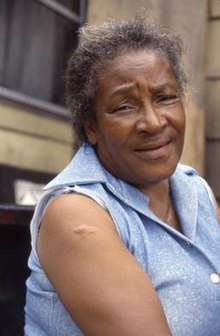Bessie Harvey
Bessie Harvey (born Bessie Ruth White, October 11, 1929–August 12, 1994) was an American artist best known for her sculptures constructed out of found objects, primarily pieces of wood. A deeply religious person, Harvey's faith and her own interest in nature were primary sources for her work.
Bessie Harvey | |
|---|---|
 Bessie Harvey, Golden Dreams (n.d.) | |
| Born | Bessie Ruth White October 11, 1929 |
| Died | August 12, 1994 (aged 64) |
| Nationality | American |
| Education | Self-taught |
Early life and family
Born in Dallas, Georgia, Harvey was the seventh of thirteen children born to Homer and Rosie Mae White. At the age of fourteen, she married Charles Harvey and settled in Buena Vista, Georgia.[1][2]She divorced Harvey in 1968 and relocated independently to Alcoa, Tennessee, where she was raising eleven children by age 35.[3][1] As a child, she recalls making "something out of nothing," often creating her own toys and dolls.[4]
In addition to having eleven children, Harvey had twenty-eight grandchildren and three great-grandchildren.[1]
Career
In 1977, Harvey began working at Blount Memorial Hospital as a housekeeper. For extra income, at night while everyone was asleep Harvey would make dolls.[2] After exhibiting her artwork at the hospital, her work drew attention and gallery representation.[5] One of the staff doctors introduced her to the directors of the Cavin-Morris Gallery in New York City, which continued to sell her work exclusively for several years.[3]
Works
Harvey's sculptures were typically wood decorated with paint, beads, shells, cloth, and other found materials, combining "performance (on the order of a puppet show) sculpture, painting, and assemblage".[6] After that time, she increasingly focused on her artwork until her death in 1994.[4]
Harvey's work belongs to a larger tradition of black vernacular art created in the American South. The assemblage aspect of her work, the use of found materials, and emphasis on religious themes are common to the black vernacular art tradition. As a creator of visionary art, She often claims that God is the main source for her work, even to the extent that He is working through her: "I’m really not the artist. God is the artist in my work; nature and insects, they shape my work for me, because they belong to God. I belong to God, and all things belong to God, because it’s in his Word that all things are made to him, that without him there’s not anything made."[7] According to Harvey, God allowed her to see anthropomorphic forms within the wood she worked with, and with that help she could give physical shape to the spiritual presences within these tree roots, limbs, and pieces of driftwood. Her interest in nature was due in part to her belief that she could access or see the spirit of her ancestors within trees, for example, and her general belief in transcendentalism.
Her work often reflected specific biblical stories, including stories from Genesis and Revelation.[5] She also created a series of works inspired by the African-American experience in the United States.[8] When naming her works, she frequently used an African-English dictionary to provide a direct connection to African culture.[1]
Exhibitions, holdings, and influence
Harvey's work has been included in over 50 exhibitions, including a posthumous inclusion in the 1995 Whitney Biennial. Her work Cross Bearers was subsequently purchased by the Whitney Museum for its permanent collection.[9] She was also the subject of a major retrospective in 1997 at the Tennessee Museum of Art.[10] Her works are in the permanent collections of the Knoxville Museum of Art[11] and the American Folk Art Museum, New York.[12][13]
Harvey has been cited as an influence by Alison Saar,[14] and a street in Alcoa has been named after her.[15]
References
- Wertkin, Gerard C (2014). Encyclopedia of American Folk Art. ISBN 9780203644485. OCLC 999123349.
- King-Hammond, Leslie (1995). Gumbo Ya Ya. New York: Midmarch Arts Press. p. 93. ISBN 1-877675-07-5.
- Hillstrom, Laurie Collier; Hillstrom, Kevin (1999). Contemporary women artists. Detroit: St. James Press.
- Harvey, Bessie. "Bird and Spirit Root by Bessie Harvey". intuitiveeye.org. Retrieved 8 March 2015.
- American Folk Art: A Regional Reference. ABC-CLIO. 2012. pp. 200–202. ISBN 9780313349362.
- Farrington, Lisa (2005). Creating Their Own Image: The History of African-American Women Artists. Oxford University Press. pp. 247–249. ISBN 9780195167214.
- Harvey, Bessie. "God is the Artist". Souls Grown Deep. Retrieved 8 March 2015.
- Morris, Shari Cavin (1987). "Bessie Harvey: the Spirit in the Wood". The Clarion. Retrieved 8 March 2015.
- Perry, Paul Wardell (2000). "Bessie Harvey's Sculpture: The Beast in the Tree Trunk". The Crisis (July–August 2000). Retrieved 8 March 2015.
- The Grove Encyclopedia of American Art, Volume 1. Oxford University Press. 2011. p. 465. ISBN 9780195335798.
- C., Wicks, Stephen (1997). Awakening the spirits : art by Bessie Harvey : an exhibition organized by the Knoxville Museum of Art, in collaboration with Austin-East High School : Knoxville, Tennessee, April 4-July 27, 1997. Harvey, Bessie, 1929-1994., Stein, Judith E., Cogswell, Robert S., Knoxville Museum of Art., Austin-East High School (Knoxville, Tenn.). Knoxville, Tenn.: The Museum. ISBN 0963588141. OCLC 37004186.
- "Ancestry & Innovation: African American Art from the American Folk Art Museum Smithsonian Institution, 2001". Archived from the original on 2010-07-21. Retrieved 2010-09-28.
- "Artists: Bessie Harvey". American Folk Art Museum. Archived from the original on 2 April 2015. Retrieved 8 March 2015.
- Women and Religion in the African Diaspora: Knowledge, Power, and Performance. JHU Press. 2006. p. 208. ISBN 9780801883699.
- Alcoa. Arcadia Publishing. 2011. p. 123. ISBN 9780738587813.
External links
- "Remembering Bessie Harvey". Maryville, TN: Blount Today. October 9, 2008. Archived from the original on March 7, 2012.